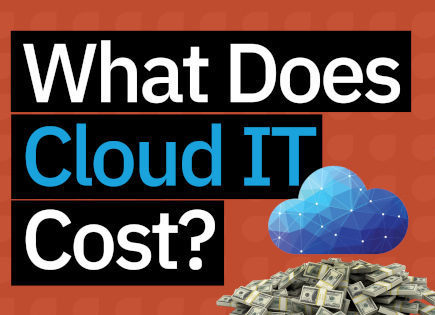
Author: Tony Zorc, CEO & Founder of Accounting Seed
Cloud-based software applications continue to overtake the tech industry. The way businesses use and buy software has dramatically shifted because of this. As companies adopt a full cloud computing model, many still don’t know what the true cost of their IT is. Why are there hidden costs? It’s time to uncover the true cost of IT in the cloud.
The IT Cloud Trend: A Definitive Look
What’s very clear is that over the past 10 years, the software needs for businesses are only growing. More and more applications are being developed to meet these demands and enhance how organizations can run their operations faster and with greater efficiency. We are still finding value in new types of software, even software that manages other software like the Salesforce CRM.
What unifies all these different applications from accounting to operations is that they are all being developed and deployed for use on the cloud. Software companies have adopted the software as a service (SaaS) business model to make these apps available via the internet and host them for the customer. Individual software companies are eliminating or reducing the need for an internal IT department because cloud-based software doesn’t require the company to have an internal network. The costs of running an IT network in-house are being replaced with software subscriptions, but these aren’t the only costs.
The 4 Costs of Cloud IT
The biggest costs of cloud software are under the surface after the subscription is purchased. These costs can be complicated to quantify without understanding how software works on the cloud. We’ve broken down the main costs of cloud computing into four main categories. Let’s look at how they add up.
Hardware
Hardware is a very clear IT cost. Even with cloud-based software, you still need to supply your staff with computers, routers, monitors, and other accessories to access and use the internet. Highly controllable, it’s easy to identify the tools you need to equip your company with. As always, only invest in quality products. Research reviews and consumer reports to ensure your business is getting the best tools possible. To save on hardware costs, try to find deals on bigger orders to fully equip your team. You’ll also want to invest in redundant equipment to ensure that work can continue in case some hardware becomes disabled. Monitoring your hardware’s life cycle will help you save time in distributing new equipment without major delays, and presents options to recover costs.
Software Subscriptions
The software subscription costs are pretty transparent, but you should always look over the contracts of the software you’re buying. This is the amount you must pay for access to the software per month. You might also have charges per user, but this is something you discuss prior to implementation. If you need more user subscriptions later, you can always sign up for more. This is a simple change to the agreement with the software company. Part of your subscription costs can also cover specialized services depending on the type of software you’re using. For example, some companies factor maintenance or assistance into your bill. These are clearly defined before you invest in the subscription.
Software Integrations
The true hidden costs of cloud IT software begin with software integration. One of the biggest and most important benefits of using the cloud is that this allows different applications to work together. But this isn’t instantaneous. Most software applications are designed independently, so they can’t easily communicate with each other. To have an IT system where apps share data and work together to streamline operations, you need IT integration to establish the connectivity. Without integration, apps will remain siloed, unable to share data. The cost of having to integrate un-connected software is a major expense of operating on the cloud, but it doesn’t end here. Integrations connecting apps that are not designed to work together almost always come with risks of recurring dysfunctions and data errors. To prevent this, the integration needs continuous maintenance, which continually adds to your IT expenses.
Software Labor
The labor surrounding cloud IT is often unclear and hidden because of the reduced focus on in-house IT management. Even in the cloud, software glitches can happen, functionalities need to be customized, and user parameters need to be updated. Labor costs can range in scope depending on the complexity of the tech you’re using. Here’s a broken-down look at the different kinds of software labor costs:
- Software administration
- Can be internal and/or external to your organization. This is the simple management of the software you’re using. Internally, this can involve managing system controls and user permissions. Externally, this may involve managing user tickets with questions of problems about the software. The costs internally would be for the staff serving as admins. While the external administration is usually part of the subscription.
- Software integration maintenance
- This is probably the biggest financial cost of cloud software. After the software integration is implemented, it must usually be maintained due to the fragility of the connection. This involves a lot of time and money and often requires technical specialists to readjust, update, and maintain the integration. Part of the costs also involves the use of middleware by these specialists. Middleware is used by integrators to establish and maintain the connections between the desired software.
- Manual integration
- This is a major cost of staff’s time and often necessary when working with siloed applications. Or, when an IT integration fails and users are forced to reconcile data to overcome errors. This involves the physical re-entry of data between different software solutions. This often takes time away from other important tasks and is very frustrating for staff. This leads to data errors and inconsistencies throughout the system.
- Data reconciliation
- This is the other half of manual integration, or manual data entry. This involves the time-intensive manual processes of checking and correcting the information between cloud applications. Again, data errors and inconsistencies can be commonplace because users are forced to constantly update systems with correct information. When integrations fail and users make mistakes because of manual data entry, reports have to be created and then carefully compared to secure the answers you need. Companies waste time and money when their essential tools can’t work together.
Top 5 Ways to Control Your Cloud IT Costs?
Cloud costs can seem unavoidable, but that’s far from the case. SaaS isn’t going away. Software subscriptions are stable business costs, but there are several things your business can do to control these expenses. Here are the top 5 things you can do to avoid or minimize cloud IT costs.
Avoid integrations
Consolidate your business apps on a single platform like Salesforce whenever possible. These business platforms rely on native applications. They are designed to communicate with each other, rendering traditional IT integration unnecessary. This lets you completely bypass the costs and risks of integration altogether.
Identify and document integration requirements thoroughly
If you must use integration to connect siloed tools, make sure that you carefully define the triggers. The data entry points and design patterns to secure the desired functionality need looked at, too. This should help minimize data errors or dysfunctions. But, bear in mind that frequent maintenance will likely still be required.
Keep up with changes in your apps
Be sure to read the release notes of new software updates in order for you to plan ahead for changes. This can save your team a lot of uncertainties and administrational costs by allowing you to plan for changes. With connected software, this helps you become aware of new functionalities to improve your processes. If you rely on integrations, this may require you to follow-up with the IT specialists managing the integration to ensure smooth transitions. Always check new functionalities in your sandbox to make sure the changes are working correctly.
Track your time carefully so you know exactly what IT is costing you
Have employees complete time cards and monitor how many hours they are working with your software’s support team. Measure how often your staff has to troubleshoot or deal with software difficulties. If you’re spending too much time and effort in dealing with software issues, it may be time to find an alternative solution. Also, look at how responsive and effective your IT support is. When you invest in software, you are paying to have your needs met within a reasonable amount of time. Otherwise, you’re wasting money.
Audit data regularly
Make sure that your data is consistent and reliably managed between your software solutions. Remember, a major benefit of cloud software is the ability to optimize and manage critical business information. If your software is causing the reverse effect, there’s a problem. If you need to upgrade functionality and features, add additional software, or utilize multiple spreadsheets to control your data, the expenses will only grow. Auditing data can help you identify and resolve issues right away before it becomes an expensive problem for your company’s operations.
How do you save on Cloud IT? Simple, watch out for those hidden expenses. Why deal with integration costs when you can get all the software you need to talk with each other on a consolidated business platform? Cloud software has unlimited potential, don’t let your company get bogged-down by costs!
See Accounting Seed in action
Get a close-up view of how accounting on Salesforce can eliminate the need for costly integrations—and silos of mismatched information—by sharing the same database as your CRM.


